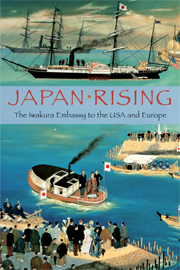Book contents
- Frontmatter
- Contents
- Introduction by Ian Nish
- Note on the Text
- VOLUME I THE UNITED STATES OF AMERICA
- Preface
- 1 The Voyage across the Pacific
- 2 A Survey of the United States of America
- 3 A Record of San Francisco, 1
- 4 A Record of San Francisco, 2
- 5 The Railroad Journey in the State of California
- 6 The Railroad Journey in the State of Nevada and Utah Territory
- 7 The Rocky Mountain Railroad
- 8 The Chicago Railroad
- 9 The Railroad Journey from Chicago to Washington, D.C.
- 10 A Survey of the District of Columbia
- 11 A Record of Washington, D.C., 1
- 12 A Record of Washington, D.C., 2
- 13 A Record of Washington, D.C., 3
- 14 The Journey Through the Northern States, 1
- 15 The Journey Through the Northern States, 2
- 16 The Journey Through the Northern States, 3
- 17 A Record of Washington, D.C.: Epilogue
- 18 A Record of Philadelphia
- 19 A Record of New York City
- 20 A Record of Boston
- VOLUME II BRITAIN
- VOLUME III CONTINENTAL EUROPE, 1
- VOLUME IV CONTINENTAL EUROPE, 2
- VOLUME V CONTINENTAL EUROPE, 3; AND THE VOYAGE HOME
- Index
2 - A Survey of the United States of America
Published online by Cambridge University Press: 04 August 2010
- Frontmatter
- Contents
- Introduction by Ian Nish
- Note on the Text
- VOLUME I THE UNITED STATES OF AMERICA
- Preface
- 1 The Voyage across the Pacific
- 2 A Survey of the United States of America
- 3 A Record of San Francisco, 1
- 4 A Record of San Francisco, 2
- 5 The Railroad Journey in the State of California
- 6 The Railroad Journey in the State of Nevada and Utah Territory
- 7 The Rocky Mountain Railroad
- 8 The Chicago Railroad
- 9 The Railroad Journey from Chicago to Washington, D.C.
- 10 A Survey of the District of Columbia
- 11 A Record of Washington, D.C., 1
- 12 A Record of Washington, D.C., 2
- 13 A Record of Washington, D.C., 3
- 14 The Journey Through the Northern States, 1
- 15 The Journey Through the Northern States, 2
- 16 The Journey Through the Northern States, 3
- 17 A Record of Washington, D.C.: Epilogue
- 18 A Record of Philadelphia
- 19 A Record of New York City
- 20 A Record of Boston
- VOLUME II BRITAIN
- VOLUME III CONTINENTAL EUROPE, 1
- VOLUME IV CONTINENTAL EUROPE, 2
- VOLUME V CONTINENTAL EUROPE, 3; AND THE VOYAGE HOME
- Index
Summary
When Columbus of Spain discovered the continent of America it was the Meiō era [1492–1501] in Japan. As is well known, the land he discovered was not the one which later became the United States of North America.
A representative government was established in Virginia in 1619 (with a governor sent from England to represent the Crown). This was the age of Queen Elizabeth I [James I] in England, where disputes over religion had erupted. Among Protestant believers there was a group called the ‘Independents’, who pleaded for the right of religious freedom. They were not satisfied with the English style of Protestantism, and in 1620 the Pilgrim Fathers – William Bradford and Edward Winslow among them – boarded a boat and sailed to America. Making landfall at Cape Cod, they pledged themselves to Heaven and established a colony in what is now the state of Massachusetts. This marked the opening of the continent of America. Subsequently, the Englishman William Penn founded the state of Pennsylvania, and Henry Hudson founded the state of New York. In addition, Danes and Frenchmen opened up various areas of wilderness. Eventually, these became British possessions and the English kings dispatched governors to oversee them. Provincial governments were established with the king's authority to rule each colony.
- Type
- Chapter
- Information
- Japan RisingThe Iwakura Embassy to the USA and Europe, pp. 10 - 13Publisher: Cambridge University PressPrint publication year: 2009



